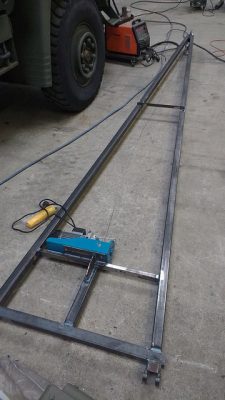Situation: there are 10 large wooden posts I need to plant in the ground for a carport build. The posts are 170 mm square by 4.5 m long. At ~100 kg per post, I can’t lift them into position on my own.

Obvious and sensible solution: rent/borrow a telehandler for the duration of the work.
More interesting solution: build a crane!
A static one might work, but it’d still be a pain getting the posts into position prior to lifting. A mobile vehicle-mounted one would be better.
It seems the DAF has some beefy lifting eyes mounted on the front of the chassis. Those would make decent mounting points. An idea is born…

I’ll skip past the boring bit (maths was involved) and onto the interesting bit. Summary of the boring bit: the design is good for a 400 kg lift. The dominant failure mode is elastic instability of the two main beams – they’re loaded almost entirely in compression. The rest of the bits are good for at least double that, so if I need to uprate it in future I just need to stiffen the two main beams – either by deepening them with additional sections, or adding a third beam and making a 3-D truss type structure.
The two lifting eyes on the front will be the main mounting point for the crane. They’ll take the majority of the load. Some load will be transferred from the tip of the crane to a pair of lifting eyes at the rear of the truck.
Anyhoo, the interesting bit.
First up, pivots to suit the lifting eyes. The lifting eye bore is 1″, so 25 mm bar did the trick for pivot pins. Some bored-out 2″ bar worked to make the external pivot parts.





Sweet. Next, some plate welded to the annular yoke parts.


Add some angle iron to tie that all together…

…and we’ve got a pivoting mount for the base of the boom.

The main beams are 50 mm box section, 4.75 m long. Apologies for the poor picture, my potato must have malfunctioned.

The tip of the boom will be held up by strops back to the rear of the truck. A decent integral mount is required for that purpose.


That’ll do nicely.
The actual lifting will be handled by an electric winch, mounted to the base of the crane.
A pulley at the tip of the boom will route the wire for either hoisting the crane into position or actually lifting stuff.
Some more angle iron to make the pulley mount:

Down at the other end, there needs to be a plate to mount the winch to.



Finally, some feet to keep it off the ground when in storage:




Alright! Let’s lift some stuff.
Bootstrapping itself into position:


And lifting stuff:


Success!

Now then, enough procrastination. There’s a car port needing built…
